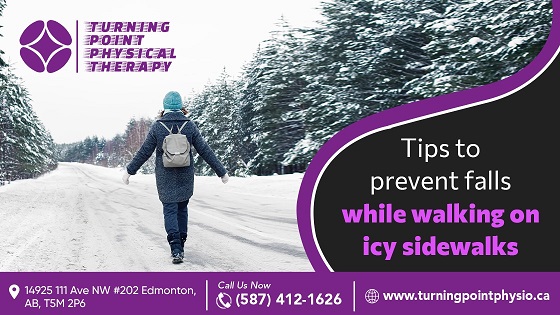Icy sidewalks pose a significant risk of slips and falls, especially during winter. Falls can lead to severe injuries such as fractures, sprains, or concussions. In Edmonton, physiotherapy implements specific tips that reduce this risk and promote confidence in navigating these hazardous surfaces. And, for those recovering from fall-related injuries, physiotherapy in Edmonton offers tailored treatments to restore mobility and strength effectively.
The Impact of Falls on Overall Health
A fall on icy sidewalks can have lasting effects beyond the immediate injury. Older adults are particularly at risk, as falls can lead to fractures that significantly impact mobility and quality of life. Even younger individuals may face extended recovery times or lingering pain from sprains and bruises. Highlighting these impacts underscores the importance of proactive fall prevention measures.
Safe Walking Tips for Icy Conditions
Below are detailed tips on safely navigating icy sidewalks and their benefits and purposes through physiotherapy in Edmonton.
1. Choose Proper Footwear
Proper footwear is crucial for safely navigating icy conditions. It involves selecting shoes or boots specifically designed for slippery surfaces. These should have rubber soles with deep treads that offer enhanced grip and stability. Before heading out, inspect the soles to ensure they are intact and free of smooth or worn areas. Attachable ice cleats can increase traction and reduce the risk of slipping for added safety in particularly icy conditions. Proper footwear improves grip and stability, reduces the likelihood of falls, and instills confidence when walking on challenging surfaces.
2. Walk Like a Penguin
The penguin walk is a simple yet effective technique for maintaining balance training on icy sidewalks. This method involves taking small, deliberate steps while shifting the weight forward to distribute it evenly. To perform this walk, stand with feet shoulder-width apart for stability, keep your steps slow and flat-footed, and slightly bend the knees to lower your center of gravity. Leaning slightly forward enhances balance further. Adopting the penguin walk improves stability, reduces strain on your legs and lower back, and adapts more quickly to icy or uneven terrain.
3. Use Handrails or Support Aids
Handrails and support aids provide valuable assistance when navigating stairs, inclines, or uneven sidewalks in icy conditions. They offer additional stability and reduce the risk of imbalance or falls. To use them effectively, grip handrails firmly whenever available, especially on stairs or ramps. A cane or walking stick equipped with an ice tip can be helpful for extra support. These aids reduce stress on the lower body and provide confidence when tackling challenging or slippery areas.
4. Plan Routes Carefully
Careful route planning can help minimize the risks posed by icy conditions. This involves choosing pathways that are better maintained and treated with salt or sand. Avoid areas prone to black ice and scan the surface ahead for shiny patches or uneven textures. When possible, opt for grassy edges or textured surfaces for better traction. Planning your route reduces exposure to high-risk areas, ensures a safer journey, and encourages mindful walking by assessing potential hazards beforehand.
5. Keep Hands Free
Keeping your hands free while walking on icy surfaces can significantly improve your balance and ability to react during a slip. Carrying items in your hands shifts the body’s center of gravity, increasing the risk of losing balance. Instead, use a secure backpack or crossbody bag to keep your arms free. Swinging your arms slightly while walking enhances stability and allows for a quicker reaction if you begin to slip. This strategy also prevents overloading your muscles and reduces strain.
6. Watch the Surface Closely
Remaining vigilant and monitoring the surface you’re walking on is essential for identifying hazards like icy patches or uneven terrain. Awareness allows you to adjust your movements proactively and avoid dangerous areas. Continuously scan the ground, especially when transitioning between surfaces, such as icy to dry pavements. Adjust your walking style as necessary to maintain steady footing. Watching the surface closely enhances situational awareness, minimizes the risk of stepping on hidden ice, and promotes a proactive approach to safety.
7. Adjust the Walking Pace
Adjusting your walking pace is a simple yet effective way to maintain stability on slippery surfaces. Slowing down and taking deliberate, measured steps gives you better control over your movements. Avoid sudden turns or quick movements that can throw off your balance. Allocate extra time for travel to avoid rushing, which often leads to accidents. By pacing yourself appropriately, you can reduce strain on your joints and muscles while minimizing the risk of falls.
8. Practice Balance and Strength Exercises
Regularly practicing balance and strength exercises can prepare your body to handle icy conditions more effectively. Activities like standing on one leg, performing squats, muscle strength, and improving proprioception.
For example, Standing on One Leg, Stand upright with feet hip-width apart. Shift your weight onto one leg and lift the other slightly off the ground, bending the knee at a 90-degree angle. Hold for 15–30 seconds, gradually increasing as balance improves. Switch legs and repeat. For safety, perform near a wall or sturdy surface. This exercise strengthens the core, ankles, and legs, enhancing stability on slippery surfaces.
Over time, these exercises prepare you for dynamic movements on slippery surfaces, reducing the likelihood of falling.
Stay Safe This Winter with Turning Point Physiotherapy
Navigating icy sidewalks doesn’t have to be a daunting task. By implementing these practical tips—you can reduce the risk of falls and stay confident in challenging weather conditions. At Turning Point Physiotherapy in Edmonton, we specialize in personalized care to help you build balance, strength, and stability. Whether you’re recovering from an injury or looking for a physiotherapist near me, our experienced team is here to guide you every step of the way.
Take the first step toward safer walking! Book a consultation today in our physiotherapy clinic, and let us help you maintain your mobility and independence this winter.

